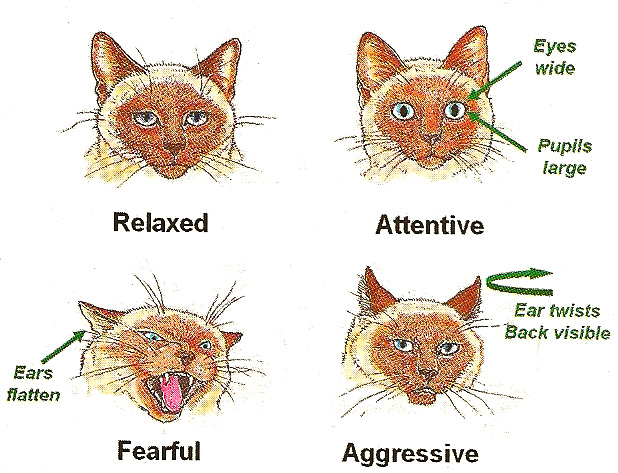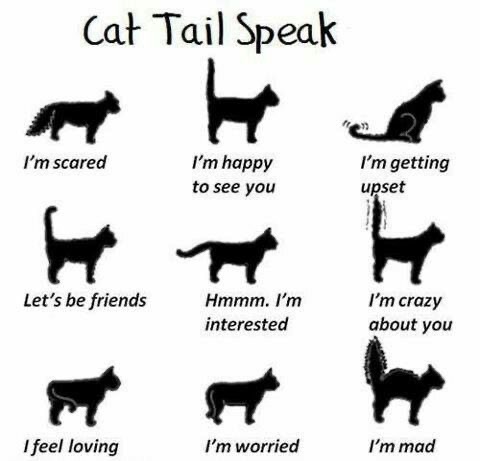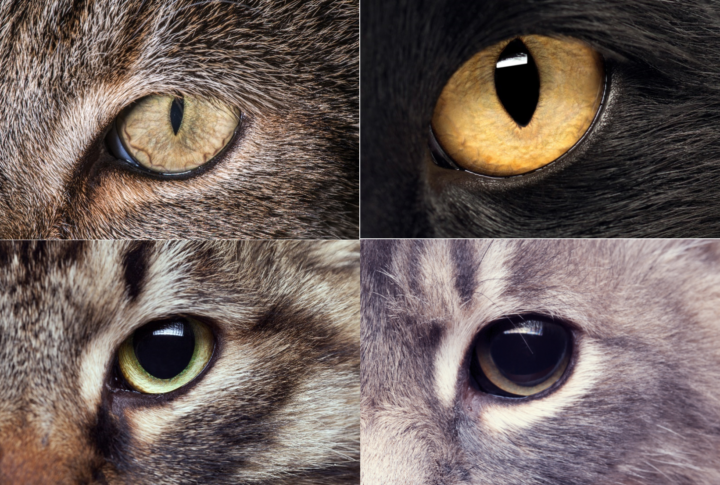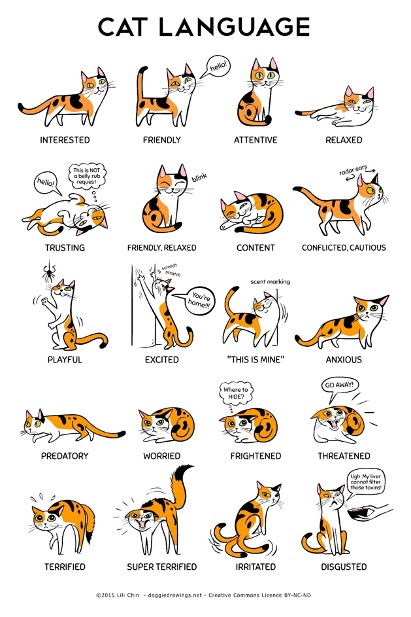How do cats talk to us?
Cats communicate how they are feeling using body language and vocalizations. It’s important that everyone who loves cats understands how to interpret what they are saying at any given moment. In the below pictures you will learn what to look for so that you know how the cat you are interacting with is feeling and what they might be trying to tell you.
*Once you have learned a little Cat 101, test your new knowledge with our “Should you pet that cat?” game at the end!

How Cats Talk With Their Ears.
Cats communicate with us using their:
- Ears
- Tail
- Eyes
- Whiskers
- Teeth
A cat’s ear position can give you an idea about how the kitty is feeling. Ears held naturally means the cat is relaxed, while ears pinned back mean the cat is afraid. When a cat’s ears are facing forward and close together, that means the cat is interested in something. And when a cat twists its ears so that the opening is to the side, that means the cat is angry.
How Cats Talk With Their Tails.
Cats tell us tons with their tails. As you can see to the right, a high tail that’s not puffy means the cat is comfortable around you but a tail that is high and puffy means the cat is upset. A tail that is parallel with the back means the cat is curious about you and a low tail that is tucked close to the body means the cat is not confident about your presence. Cats also “wag” their tails to tell you they are happy or angry. The slow and soft wag means they are enjoying your pets and feeling happy. However, if that tail begins wagging faster and more aggressively, almost like a thrash, then that means the cat is getting irritated and you should stop petting (or whatever it is you’re doing).


How Cats Talk With Their Eyes.
Like humans, cats’ eyes dilate and contract with the change of light. They also dilate and contract based on their mood. You may have noticed that your cat’s eyes dilate and are nice and big and round (figure 4) when they are playing with a toy or watching a bird.
They will also enlarge their pupils when they are angry or afraid. For example, if you are petting a cat and their eyes start out slit-like (figure 1) and then very quickly turn big and round (figure 3-4) then stop petting them and assess the situation. Is it you? Is it the part of their body you just touched where they do not like being pet? Is it another cat in the room? Is it the bird that just flew by the window? This is how we learn what makes our cat tick.
Some cats just don’t like being pet for more than a few minutes at a time and want to resume their business (and for you to go about yours). Cats have a wide range of personalities, likes and dislikes. Yes, it takes time to learn them, but we must take the time to do it.

How Cats Talk With Their Whiskers.
Whiskers not only act as a sensory aid for cats to find their way around in the dark, they also can tell us how a cat is feeling. If a cat’s whiskers are forward and fanned out, then the cat is interested in something. If a cat’s whiskers are pressed tight to their face, the cat is most likely afraid and is attempting to make itself look smaller.
How to properly approach an unfamiliar cat.
Sometimes cats can give us mixed signals and we are not sure whether they want to be pet or not. The way to test if they want to be petted is with a “kitty cat handshake.” Slowly offer your fingertip or knuckle for the cat to smell (be careful not to scare the cat by moving your hand in a fast or jerky motion). If the cat gives your hand a head butt, they are asking for more interaction. Not all cats will give you head butts because they’re not sure what you want, in this case, to see if they want pets slowly offer to scratch the underside of their chin and/or the side of their face. If the cat moves their head away from you – they do not want to be petted, please respect their rejection.
Many cats (and dogs) are head shy, meaning that when they see a large hand coming straight over their head they get nervous or afraid because they’re not sure if you’re going to grab or maybe even hit them. So, under the chin scratches are the best bet in order to make a fast friend! Start underneath and slowly work your way to the back of the ear and then to the back of their head. Then you can pet from the head to their tail in nice even strokes until they give you a signal to “please stop”.
One last word.
Hopefully, you have now learned that cats express how they are feeling in so many different ways. Usually they use a combination of communication signals through their ears, eyes, and body posture. Responsible pet owners and guardians need to learn how to read their cats body language and be understanding of their emotions. If they do not want pets, then do not pet them, and ask that others do the same. If they are in play-mode, it may not be the best time for pets. Every cat has a different “petting threshold” meaning that some cats don’t mind being pet for a really long time and other cats only want a few minutes worth of petting before they are done.
When a cat is upset or afraid they are likely to give a not-so-friendly paw swat or a leave-me-alone hiss. If you pay attention to what the cat is trying to tell you before they resort to these behaviors everyone will be better off – you and the cat. Listen to them, respect them, and most of all love them.
Written by Nayla Garcia
Test your knowledge!
Ready to test your newfound cat expertise? Practice what you’ve learned and play our game “Should you pet that cat?” by clicking below!

